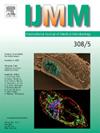Desiccation tolerance and reduced antibiotic resistance: Key drivers in ST239-III to ST22-IV MRSA clonal replacement at a Malaysian teaching hospital
IF 3.6
3区 医学
Q1 MICROBIOLOGY
引用次数: 0
Abstract
Molecular surveillance of methicillin-resistant Staphylococcus aureus (MRSA) isolated from Hospital Canselor Tuanku Muhriz (HCTM), a Malaysian teaching hospital revealed clonal replacement events of SCCmec type III-SCCmercury to SCCmec type IV strains before the year 2017; however, the reasons behind this phenomenon are still unclear. This study aimed to identify factors associated with the clonal replacement using genomic sequencing and phenotypic investigations (antibiogram profiling, growth rate and desiccation tolerance determination, survival in vancomycin sub-minimum inhibitory concentration (MIC) determination) of representative HCTM MRSA strains isolated in four-year intervals from 2005 – 2017 (n = 16). HCTM Antimicrobial Stewardship (AMS) and Infection Prevention and Control (IPC) policies were also reviewed. Phylogenetic analyses revealed the presence of 3 major MRSA lineages: ST239-III, ST22-IV and ST6-IV; MRSAs with the same STs shared similar core and accessory genomes. Majority of the ST239-III strains isolated in earlier years of the surveillance (2005, 2009 and 2013) were resistant to many antibiotics and harboured multiple AMR and virulence genes compared to ST22-IV and ST6-IV strains (isolated in 2013 and 2017). Interestingly, ST22-IV and ST6-IV MRSAs grew significantly faster and were more resistant to desiccation than ST239-III (p < 0.05), even though the later clone survived better post-vancomycin exposure. Intriguingly, ST22-IV was outcompeted by ST239-III in broth co-cultures; though it survived better when desiccated together with ST239-III. Higher desiccation tolerance and fewer carriage of AMR genes by ST22-IV, together with reduction of antibiotic selection pressure in HCTM (due to AMS and IPC policies) during 2005 – 2017 may have provided the clone a competitive edge in replacing the previously dominant ST239-III in HCTM. This study highlights the importance of MRSA surveillance for a clearer picture of circulating clones and clonal changes. To our knowledge, this is the first genomic epidemiology study of MRSA in Malaysia, which will serve as baseline genomic data for future surveillance.
耐干燥性和抗生素耐药性降低:马来西亚一家教学医院从 ST239-III 到 ST22-IV MRSA 克隆替换的关键驱动因素。
对马来西亚教学医院Canselor Tuanku Muhriz医院(HCTM)分离出的耐甲氧西林金黄色葡萄球菌(MRSA)进行分子监测发现,2017年之前,SCCmec III型-SCCmercury菌株克隆替换为SCCmec IV型菌株的事件时有发生;然而,这一现象背后的原因仍不清楚。本研究旨在利用基因组测序和表型调查(抗生素谱分析、生长速度和干燥耐受性测定、万古霉素次最低抑菌浓度(MIC)测定中的存活率),对2005-2017年四年间分离的具有代表性的HCTM MRSA菌株(n = 16)进行研究,以确定与克隆置换相关的因素。此外,还审查了哈医大一院抗菌药物管理(AMS)和感染预防与控制(IPC)政策。系统发育分析表明存在 3 个主要的 MRSA 系:ST239-III、ST22-IV 和 ST6-IV;具有相同 ST 的 MRSA 共享相似的核心基因组和附属基因组。与 ST22-IV 和 ST6-IV 株系(分离于 2013 年和 2017 年)相比,早些年(2005 年、2009 年和 2013 年)分离的 ST239-III 株系大多对多种抗生素具有耐药性,并携带多种 AMR 和毒力基因。有趣的是,ST22-IV和ST6-IV MRSA比ST239-III生长得更快,对干燥的耐药性也更强(p < 0.05),尽管后者在万古霉素暴露后存活率更高。有趣的是,在肉汤共培养中,ST22-IV 被 ST239-III 竞争;但当它与 ST239-III 一起干燥时,存活率更高。ST22-IV 更强的干燥耐受性和更少的 AMR 基因携带,再加上 2005 - 2017 年间 HCTM 中抗生素选择压力的降低(由于 AMS 和 IPC 政策),可能为该克隆提供了竞争优势,从而取代了之前在 HCTM 中占主导地位的 ST239-III。这项研究强调了 MRSA 监测对于更清晰地了解循环克隆和克隆变化的重要性。据我们所知,这是马来西亚首次对 MRSA 进行基因组流行病学研究,这将成为未来监测的基线基因组数据。
本文章由计算机程序翻译,如有差异,请以英文原文为准。
求助全文
约1分钟内获得全文
求助全文
来源期刊
CiteScore
9.70
自引率
0.00%
发文量
18
审稿时长
45 days
期刊介绍:
Pathogen genome sequencing projects have provided a wealth of data that need to be set in context to pathogenicity and the outcome of infections. In addition, the interplay between a pathogen and its host cell has become increasingly important to understand and interfere with diseases caused by microbial pathogens. IJMM meets these needs by focussing on genome and proteome analyses, studies dealing with the molecular mechanisms of pathogenicity and the evolution of pathogenic agents, the interactions between pathogens and host cells ("cellular microbiology"), and molecular epidemiology. To help the reader keeping up with the rapidly evolving new findings in the field of medical microbiology, IJMM publishes original articles, case studies and topical, state-of-the-art mini-reviews in a well balanced fashion. All articles are strictly peer-reviewed. Important topics are reinforced by 2 special issues per year dedicated to a particular theme. Finally, at irregular intervals, current opinions on recent or future developments in medical microbiology are presented in an editorial section.

 求助内容:
求助内容: 应助结果提醒方式:
应助结果提醒方式:


